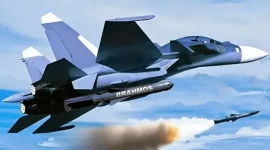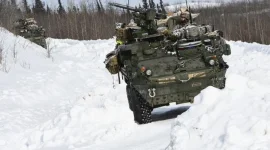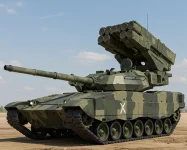- Views: 2K
- Replies: 11
The Indian Army is initiating a major upgrade for its T-90 Bhishma main battle tanks, seeking collaboration with the nation's private defence industry to develop and install advanced, autonomous anti-drone systems.
This initiative aims to significantly bolster the protective capabilities of the T-90, a cornerstone of India's armoured forces, against the increasing threat posed by unmanned aerial vehicles (UAVs) on the modern battlefield.
India currently operates a large fleet of over 1,200 T-90 tanks, with more undergoing licensed production domestically. The plan involves integrating an Artificial Intelligence (AI)-driven system with the tank's existing 12.7 mm anti-aircraft machine gun (AAG).
At present, this weapon is operated manually by the tank commander, requiring visual sighting and engagement. The new system is envisioned to provide automated, 360-degree detection, tracking, and engagement capabilities against low-flying aerial threats like drones.
The T-90's current anti-aircraft setup features a 12.7 mm NSV heavy machine gun mounted on the turret, controlled remotely using the commander's sight integrated into the tank's fire control system.
While improvements have been made to this system by Indian companies since its original Russian design, the manual operation limits reaction time and effectiveness against small, fast-moving drones.
Lessons from recent global conflicts, particularly in Ukraine, have highlighted the vulnerability of heavily armoured vehicles to attacks from drones and loitering munitions, prompting the need for automated defence solutions.
The Army's requirements specify a system capable of autonomously scanning the surrounding airspace. It must detect potential threats up to 5,000 metres away, recognise them at 3,000 metres, and positively identify targets at 2,000 metres using AI algorithms.
Upon identifying a hostile drone, the system would alert the crew, allowing the commander to confirm the engagement or manually override the process. This automation is expected to drastically reduce response times and enhance the crew's situational awareness, freeing them to concentrate on ground combat operations.
A key component of this upgrade is the parallel development of specialised fragmentation ammunition for the 12.7 mm AAG. Unlike standard rounds, these munitions are designed to explode near the target, releasing shrapnel to maximise the chances of hitting and disabling agile drones.
The ammunition must incorporate a safety feature, likely a proximity or timed fuse, ensuring it detonates only at a safe distance from the tank itself, preventing accidental damage to the vehicle or nearby friendly units.
This approach aligns with other Indian initiatives, such as upgrading older air defence guns like the ZU-23 and Schilka systems with similar anti-drone ammunition.
This move directly addresses a critical vulnerability observed in contemporary warfare, where even advanced tanks like the T-90 Bhishma, equipped with features like explosive reactive armour (Kontakt-5) and sophisticated fire control systems, remain susceptible to attacks from above.
While the Indian Army is also exploring other defensive technologies like Active Protection Systems (APS), the integration of an autonomous capability onto the existing AAG offers a potentially quicker and more cost-effective enhancement to counter immediate aerial threats well before they reach weapon deployment range.
Developing such a system presents significant technical challenges. The AI software needs sophisticated training to reliably distinguish small drones from other objects like birds or friendly aircraft across all directions and in various weather conditions.
Achieving the required detection and identification ranges will likely necessitate high-resolution electro-optical and infrared (EO/IR) sensors, possibly supplemented by compact radar systems.
Integrating these new components seamlessly with the T-90's existing power supply, weight limitations, and fire control system will demand considerable innovation from the participating private sector firms.



